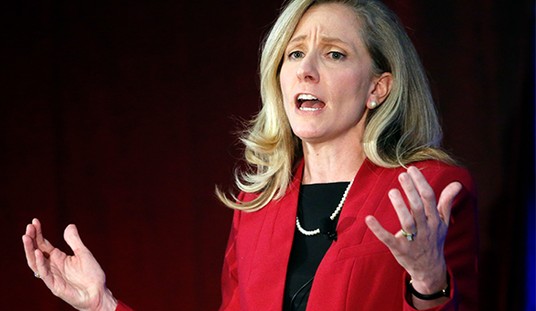No one? NIAID chief Dr. Anthony Fauci joined our colleague Hugh Hewitt this morning to discuss the parameters of social distancing and the development of the government response to the COVID-19 pandemic. It’s a fascinating conversation, worth listening to in its entirety, but Fauci made two observations that will need careful consideration in the days and weeks ahead.
Let’s start with the more pessimistic news. Even if all this mitigation succeeds in tamping down COVID-19, it might not just disappear with the warm weather. And even if it does, there’s no guarantee that it will disappear as the related SARS virus did nearly twenty years ago:
HH: Now Dr. I want to close with you, and Senator Cotton’s coming up pretty quick. But the big unanswered question, because I don’t know that many members of the White House press corps have actually read The Great Influenza, is that between its appearance in Kansas in the spring of 1918 and its devastating second wave, it went through 12 iterations according to John Barry’s book. And the second and third and fourth, they got deadlier. The hardest question for me to answer is during the summer when the virus appears to disappear, will it be iterating into a more deadly virus? Is there any science to tell us if we’re like getting crowd immunity, or if it’s going to come back in a more virulent form?
AF: You know, we do not know. When we suppressed the SARS Coronavirus, it went away and never came back. We are hoping that if we can suppress this by mitigation and by containment over the next few months that when we get into the deep summer, that it will disappear. If it doesn’t and comes back, hopefully, that will give us more breathing room to develop therapies as well as a vaccine. But the direct answer to your question is we do not know if it will come back and how it will come back. It’s a possibility, but we just need to be prepared for it.
HH: I was cheered yesterday by the record-setting initiation of a trial on a vaccine. I am curious if there is other good news on interventions for those who are suffering from virus pneumonia and related, there’s some pretty awful related maladies. Are they any new interventions that have crossed your screen?
AF: Oh, there are several that are in clinical trial. They have not yet been proven to be effective, but there are a number of interventions, what we call therapies, direct antiviral therapies that are being tested in China, and some that are even being tested here in the United States.
There are actually two tracks in treating a disease — vaccines for prevention and therapies for treatment and recovery. The US and everyone else is pursuing both, of course, but vaccines might take longer to develop than therapeutic strategies. Right now laboratories are testing out already-marketed drugs to see if they can effectively fight COVID-19, which holds promise for a quick attack on the disease. Therapeutic strategies won’t prevent recurrence year on year, though, and even vaccines are limited in that sense, which we find every year with influenza.
On the other hand, SARS disappeared entirely after its first run. With any luck, this related coronavirus will do the same, but don’t necessarily bet on it. We just may end up with more of a herd resistance to it after this pass, but that comes at an ugly cost unless we can develop an effective therapeutic strategy quickly for the higher-risk populations. Allahpundit wrote about this earlier, so be sure to check out his analysis of it if you haven’t already.
Update: This seems promising:
When it comes to #COVID19, we'll take all the encouraging data we can.
Case report that non-severe patient does develop immune response to the #coronavirushttps://t.co/UtZlWzTGtq
Reinfection could not occur in #SARSCoV2 infected rhesus macaqueshttps://t.co/Wtd4WK69oG … pic.twitter.com/dvil10CzGU
— Andy Biotech (@AndyBiotech) March 17, 2020
Original post continues …
Part of these solutions requires quantifying the disease transmission in the population and determining just how deadly it actually is. We got off to a late start on that despite getting warnings about its contagious nature early on. The media has blamed the Trump administration and the CDC for the lack of testing capability, but is that fair? Fauci says it’s not really anyone’s fault — and that regulations meant for normal times just got in the way when it came to an emergency:
HH: Now my last technical question has to do with the CDC and the testing breakdown. Was that because of regulatory capture? Was that because the CDC always prefers its own work? Was that simply because we were not, we’ve never, I think what the President was saying yesterday is while we’ve confronted Ebola and H1N1, we’ve never confronted as fast a moving virus as this one before that is so elusive to diagnose. What happened on the testing development?
AF: You know, it was a complicated series of multiple things that conflated that just, you know, went the wrong way. One of them was a technical glitch that slowed things down in the beginning. Nobody’s fault. There wasn’t any bad guys there. It just happened. And then when we realized, when the CDC realized, and the FDA said both the system itself as it was set up, which serves certain circumstances very well, was not well-suited to the kind of broad testing that we needed the private sector to get involved in. The regulatory constraints, which under certain circumstances are helpful and protective of the American people were not suited to the emergence of this particular outbreak. So there was a confluence of a bunch of things. I believe now that the CDC and the FDA and the Department, that we’ve got it right now, because we’re handing much of it over to the private sector to heavy hitter companies that do this for a living. And I think what you’re going to be seeing looking forward is a major, major improvement in the availability of testing.
HH: Was the glitch or anything about the production of the test President Trump’s fault? Or actually, let me put it more broadly, would every president have run into the same problem?
AF: Oh, absolutely. This has nothing to do with anybody’s fault, certainly not the President’s fault.
Oddly enough, the Washington Post concurred with Fauci’s view. In a report last night, the Post also focused on regulatory obstacles to getting the private sector engaged as the chief cause of the testing delay. Now that the Trump administration has removed those obstacles, including an FDA ruling allowing states to certify tests they develop themselves, the problem should be resolved soon:
The United States’ struggles, in Landt’s view, stemmed from the fact the country took too long to use private companies to develop the tests. The coronavirus pandemic was too big and moving too fast for the CDC to develop its own tests in time, he said.
“There are 10 companies in the U.S. who could have developed the tests for them,” Landt said. “Commercial companies will run to an opportunity like this.” …
First, the CDC moved too slowly to tap into the expertise of academia and private companies such as Landt’s, experts said. For example, it wasn’t until last week that large companies such as Roche and Thermo Fisher won approval from the Food and Drug Administration to produce their own tests.
Moreover, while FDA and CDC officials have attributed some of the testing delays to their determination to meet exacting scientific standards they said were needed to protect public health, the government effort was nevertheless marred by a widespread manufacturing problem that stalled U.S. testing for most of February. …
But critics say government officials should have moved much more quickly to bring on expertise from outside the CDC.
“The CDC has good scientists and they are proud,” Landt said. “But in this situation, they took the wrong approach.”
That’s not quite the same thing as saying that “no one is to blame,” but it’s probably close enough for government work, if readers will pardon the tweak. The CDC found itself locked into a process which makes sense in non-emergency situations. Having the CDC control the first attempts at making tests and then engaging the private sector allows for theoretically stricter quality control but adds a lot of time to the curve for massive testing. In this case, even the theoretical quality control didn’t pan out, as the CDC’s first attempts turned out to be failures anyway. Even if it had been successful, though, the regulatory process and the CDC’s insistence on primacy is unsuited to emergencies and pandemics.
That’s a lesson learned from COVID-19, but it won’t be the last one. Hugh asks Fauci if he’s aware that he’ll basically be a main character in stories yet to be written about how to handle pandemics of this nature, but Fauci says he’s just too damn busy to think about those implications. That doesn’t mean they don’t exist, and Fauci is going to end up writing the new book and regulatory policies after this crisis is over, either directly or by example.
Be sure to watch the whole interview.








